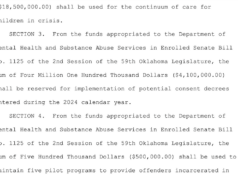
(Editor’s note: This article discusses suicide. Thoughts of suicide can be common, but just because you may have those thoughts doesn’t mean you have to act on them. If you or someone you know is thinking of suicide, please contact the National Suicide Prevention Lifeline at 1-800-273-TALK.)
Every July since 1970, thousands of baton twirlers from all over the United States, including Oklahoma, have descended upon the University of Notre Dame for a national baton-twirling competition. It is the Olympics of baton twirling, where elite athletes compete for titles they have spent much of their lives training to win. Those titles sometimes pave the way to life-changing opportunities such as full-ride college scholarships.
Sadly, owing to the pandemic, the annual competition was canceled in 2020 and 2021, disrupting the lives of young, elite twirlers all over America. Like many other young athletes, some were left completely devastated by the loss of lifelong dreams and once-in-a-lifetime opportunities.
From the outside, a canceled dance competition, prom, baseball season or even a graduation ceremony might not seem like a great tragedy. But for a young person, it can be devastating. This is just one example of how the COVID-19 pandemic has taken an especially hard toll on kids, often in ways that are not obvious to adults. Missing out on important milestones and treasured traditions can cause emotional wounds for children and teens. In addition, isolation from friends can scar young people.
In fact, according to a recent study by the U.S. Centers for Disease Control, there has been a significant rise in suspected suicide attempts, specifically among teen girls during the global pandemic. Here in Oklahoma — which has one of the highest youth suicide rates in the country — we should pay close attention to these trends as we try to understand their causes and take action to curb them in the future.
Young females have experienced extreme distress
There is a lot to unpack in the CDC study, but here is the most alarming data point: Visits to the emergency room for suspected suicide attempts among girls aged 12-17 were 26 percent higher during parts of 2020 and 50 percent higher during parts of 2021 than they were in 2019.
It is important to note that the rise in emergency department visits does not necessarily mean suicide deaths have increased. According to the CDC, the suicide rate among young persons aged 15–24 years during this same period saw no significant change
The primary takeaway from this study is that young females experienced extreme distress during the pandemic. Much of this distress is ongoing, and there is a critical need to increase our attention to this population.
The CDC study cited a number of reasons for this alarming rise in suicide attempts:
- Physical distancing, including a lack of connectedness to friends, teachers, and schools;
- Barriers to accessing mental health treatment ;
- Increased substance use;
- Increased anxiety about family health;
- Increased anxiety about economic problems;
- Because families were spending more time at home together, adults might have become more aware of childrens’ suicidal thoughts and behaviors and were more likely to take them to the emergency department.
Sadly, it is likely the CDC study under-represents the true prevalence of suspected suicide attempts in the past couple of years because, during the pandemic, many people were avoiding settings where they might contract COVID-19, such as hospitals.
Youth suicide in Oklahoma
Youth suicidality is by no means a problem brought on entirely by the pandemic, however. Well prior, youth suicide had become a major public health problem in Oklahoma with devastating effects on communities and families for decades.
According to a state health report released earlier this year, Oklahoma is among the 10 states with the highest rate of youth suicide. This is not a new development. Oklahoma has made this list throughout my 30-year career in mental health. Meanwhile, every week, two young Oklahomans between the ages of 10 and 24 take their own lives. After all these years, it still crushes me to think of the lives we lose to something preventable — something that is a symptom of treatable mental health conditions.
But the purpose of this article is not to highlight youth suicide prevention strategies. Instead, I want to look at the issue through a wider lens and remind Oklahoma’s policymakers that our state was a hard place for young people to grow up prior to the pandemic. It is an even tougher place for many of them now. Those most affected by the pandemic are lonelier, hungrier, sicker and poorer than ever.
These perpetual problems demand a level of compassionate and intelligent leadership — the kind of leadership that focuses more on problems than politics, more on saving lives than winning campaigns.
Finally, this fall, a handful of Oklahoma baton twirlers will take to football fields during Friday night halftime shows. From Tuttle to Washington, Bixby to Piedmont, Stillwater to Norman, Edmond to Enid, stadium lights will illuminate the gleam from their batons.
May their hopes, along with the hopes of all our young people, continue to rise in the face of difficult circumstances and burn as bright as the stars over the Oklahoma prairie.





















